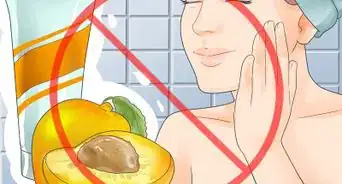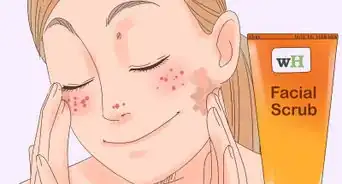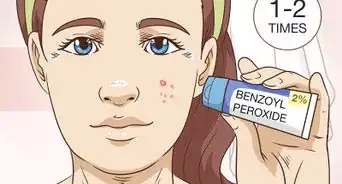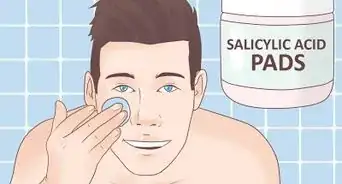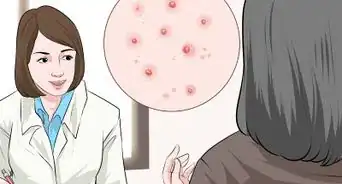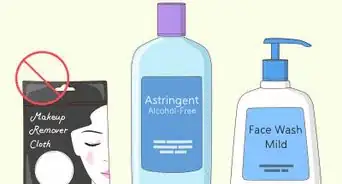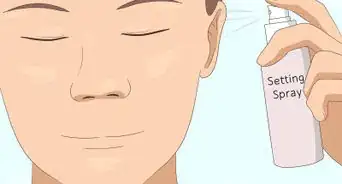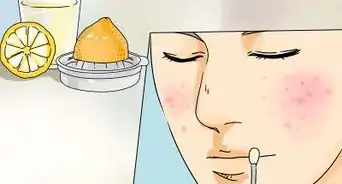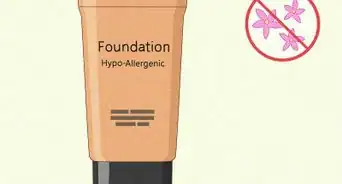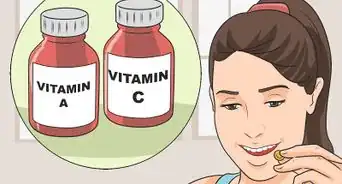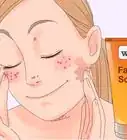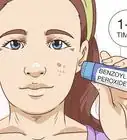This article was co-authored by Chloe Goldman. Dr. Chloe Goldman, MD is a Dermatologist based in Miami, Florida, who currently works at Baumann Cosmetic & Research Institute and Upper East Side Dermatology. She specializes in cosmetic, medical, and surgical dermatology. She earned a Doctor of Medicine from New York University and a BA in Biology, Neurobiology, and Behavior from Cornell University. She completed her dermatology training at University of Miami, where she was awarded the prestigious position of Chief Resident. She has won grants from the American Skin Foundation and the Melanoma Research Foundation.
wikiHow marks an article as reader-approved once it receives enough positive feedback. In this case, 100% of readers who voted found the article helpful, earning it our reader-approved status.
This article has been viewed 1,800,670 times.
If you have a sudden, monster zit that you want to get rid of, you can use a crushed aspirin in water to reduce its size and redness. Be very careful when using this treatment, however, as the long-term affects of aspirin usage like this are not known. However, it is known that aspirin is a blood-thinner and using too many aspirins on your face (where your skin will absorb it into your bloodstream) can be bad for you.
Steps
Using Aspirin on Your Face
-
1Crush 1 aspirin. You need it to be fully crushed for this to work well. You can use 1 to 3 aspirins, but do not use much more than that. Remember, just as you wouldn't swallow a bunch of aspirin without asking a doctor, you don't want to put a bunch of aspirin on your face without talking to a doctor.[1]
- Using more than a couple aspirins, especially within a short period of time (like 5 or 10 aspirins per day), can lead to blood-thinning issues as it is absorbed into your bloodstream. While it won't cause ulcers, that much aspirin being absorbed into your blood stream is not good![2]
-
2Mix the crushed aspirin with water. You'll want 2 to 3 parts water to 1 part aspirin. You want to have a thick, somewhat gritty paste, which shouldn't take more than a few drops of water (since you're only using 1 aspirin).[3]Advertisement
-
3Apply the paste directly on the pimple(s). Make sure to use a clean Q-tip, or, if you prefer to use a finger, wash it thoroughly with soap and / or rubbing alcohol first to ensure that you don't add new bacteria to your skin.
-
4Keep the aspirin there for 15 minutes. You do not want to leave aspirin on your skin for longer than 15 minutes. Otherwise your skin will absorb a lot of aspirin into your bloodstream, where it will remain for awhile.[4]
-
5Use a clean, wet tissue to remove the aspirin. This can also be an opportunity for light, gentle exfoliation.
Using More Natural Pimple Reducers
-
1Use tea-tree oil. Tea tree oil may reduce lesions and fight acne.[5] Apply a little tea tree oil to your pimple until it goes away.
-
2Apply a raw potato slice to your skin. Leave it on for a few minutes and then wash the potato residue off your skin with cold water.[6]
Warnings
- Do not use this method if you have Reye's syndrome, have consumed large amounts of alcohol, are pregnant or breast-feeding, or take other medications.⧼thumbs_response⧽
- If you are under 18 years of age and are experiencing the cold or flu-like symptoms, avoid all aspirin products.⧼thumbs_response⧽
- Aspirin is related to tinnitus, a ringing in the ears. If you already experience ringing in the ears, you should avoid this procedure.⧼thumbs_response⧽
- Though rare, some are allergic to aspirin. Check to see if you are by testing the aspirin spot treatment behind your ear.⧼thumbs_response⧽
- Do not try this with other pain relievers. Only use 100% aspirin. This method will not work with acetaminophen (Tylenol), ibuprofen (Advil), or most other common pain relievers. Do not use combination pain relievers such as Excedrin.⧼thumbs_response⧽
- Do not make an aspirin mask, or if you do, use fewer than 3 aspirins, put it on your face for 15 minutes or less, and repeat only occasionally.⧼thumbs_response⧽
- Since you can absorb chemicals through your skin and the long term impacts of applying aspirin topically are unknown, it's not recommended that you make a habit of this.[7]⧼thumbs_response⧽
Expert Interview

Thanks for reading our article! If you'd like to learn more about removing pimples, check out our in-depth interview with Chloe Goldman.
References
- ↑ https://www.youtube.com/watch?v=HU5XgWXMBCo
- ↑ http://circ.ahajournals.org/content/88/2/556.full.pdf
- ↑ https://www.youtube.com/watch?v=HU5XgWXMBCo
- ↑ http://www.academia.edu/3376280/PREPARATION_AND_EVALUATION_OF_ASPIRIN_TRANSDERMAL_PATCH_USING_HPMC
- ↑ http://well.blogs.nytimes.com/2011/01/27/remedies-tea-tree-oil-for-acne/?_php=true&_type=blogs&_r=0
- ↑ https://www.ncbi.nlm.nih.gov/pubmed/23454444
- ↑ http://www.nwpii.com/ajbms/papers/AJBMS_2010_2_04.pdf
About This Article
If you want to use aspirin to reduce your pimple’s redness and size, start by crushing 1 tablet and mixing it with a few drops of water. Once you’ve worked the aspirin and water into a gritty paste, use your finger or a clean cotton swab to apply it directly on your pimple. Then, let the aspirin sit on your skin for 15 minutes and absorb into your bloodstream. After 15 minutes, wipe the paste off with a wet tissue or washcloth. Avoid leaving the aspirin on your skin for longer than 15 minutes, because it is a blood thinner and can be bad for you in large doses. For more tips, like how to treat your pimple using natural methods, read on.
-Step-1-Version-3.webp)
-Step-2-Version-3.webp)
-Step-3-Version-3.webp)
-Step-4-Version-3.webp)
-Step-5-Version-3.webp)
-Step-6-Version-2.webp)
-Step-7-Version-2.webp)

